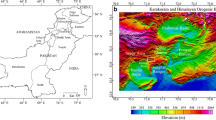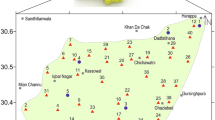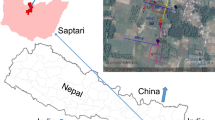Abstract
A decline in surface water sources in Pakistan is continuously causing the over-extraction of groundwater resources which is in turn costing the saltwater intrusion in many areas of the country. The saltwater intrusion is a major problem in sustainable groundwater development. The application of electrical resistivity methods is one of the best known geophysical approaches in groundwater study. Considering the accuracy in extraction of freshwater resources, the use of resistivity methods is highly successful to delineate the fresh-saline aquifer boundary. An integrated geophysical study of VES and ERI methods was carried out through the analysis and interpretation of resistivity data using Schlumberger array. The main purpose of this investigation was to delineate the fresh/saline aquifer zones for exploitation and management of fresh water resources in the Upper Bari Doab, northeast Punjab, Pakistan. The results suggest that sudden drop in resistivity values caused by the solute salts indicates the saline aquifer, whereas high resistivity values above a specific range reveal the fresh water. However, the overlapping of fresh/saline aquifers caused by the formation resistivity was delineated through confident solutions of the D-Z parameters computed from the VES data. A four-layered unified model of the subsurface geologic formation was constrained by the calibration between formation resistivity and borehole lithologs. i.e., sand and gravel-sand containing fresh water, clay-sand with brackish water, and clay having saline water. The aquifer yield contained within the fresh/saline aquifers was measured by the hydraulic parameters. The fresh-saline interface demarcated by the resistivity methods was confirmed by the geochemical method and the local hydrogeological data. The proposed geophysical approach can delineate the fresh-saline boundary with 90% confidence in any homogeneous or heterogeneous aquifer system.





Similar content being viewed by others
References
ABEM Instrument, AB. (2006). Terrameter SAS4000/SAS1000 LUND Imaging system, instruction manual.
Adepelumi, A. A., Ako, B. D., Ajayi, T. R., Afolabi, O., & Omotoso, E. J. (2008). Delineation of saltwater intrusion into the freshwater aquifer of Lekki Peninsula, Lagos, Niger. Journal of Environmental Geology, 565, 927–933.
Akhter, G., & Hasan, M. (2016). Determination of aquifer parameters using geoelectrical sounding and pumping test data in Khanewal District, Pakistan. Open Geosciences, 8, 630–638.
Baharuddin, M. F. T., Talib, S., Hashim, R., Abidin, M. H. Z., & Ishak, M. F. (2011). Time-lapse resistivity investigation of salinity changes at an ex-promontory land: a case study of Carey Island, Selangor, Malaysia. Environmental Monitoring and Assessment, 180, 345–369.
Bakhsh, A., & Awan, Q. A. (2002). Water issues in Pakistan and their remedies. In National Symposium on Drought and Water Resources in Pakistan 16 March (pp. 145–150). Lahore, Pakistan: CEWRE. University of Engineering and Technology.
Barlow, P. M., & Reichard, E. G. (2010). Saltwater intrusion in coastal regions of North America. Hydrogeology Journal, 18, 247–260.
Bauer, P., Supper, R., Zimmermann, S., & Kinzelbach, W. (2006). Geoelectrical imaging of groundwater salinization in the Okavango Delta, Botswana. Journal of Applied Geophysics, 60, 126–141.
Benabdelouahab, S., Salhi, A., Himi, M., Stitou el Messari, J. E., & Casas Ponsati, A. (2019). Geoelectrical investigations for aquifer characterization and geoenvironmental assessment in northern Morocco. Environment and Earth Science, 78, 209–216. https://doi.org/10.1007/s12665-019-8221-4.
Capaccionia, B., Diderob, M., Palettab, C., & Didero, L. (2005). Saline intrusion and re-freshening in a multilayer coastal aquifer in the Catania Plain (Sicily, Southern Italy): dynamics of degradation processes according to the hydrochemical characteristics of groundwater. Journal of Hydrology, 307, 1–16.
Cardona, A., Carrillo-Rivera, J. J., Huizar, A., Ivarez, R., & Graniel-Castro, E. (2004). Salinization in coastal aquifers of arid zones: an example from Santo Domingo, Baja California Sur, Mexico. Environmental Geology, 45, 350–366.
Gao, Q., Shang, Y., Hasan, M., Jin, W., & Yang, P. (2018). Evaluation of a weathered rock aquifer using ERT method in South Guangdong, China. Water, 10, 293.
Haq, A. U. (2002). Drought Mitigation interventions by improved water management: a case study from Punjab-Pakistan. In In Proceedings of the 18th International Congress on Irrigation and Drainage, Montreal, Canada (pp. 21–28) July.
Hasan, M., Shang, Y., Jin, W., & Akhter, G. (2019a). Investigation of fractured rock aquifer in South China using electrical resistivity tomography and self-potential methods. Journal of Mountain Science, 16(4), 850–869.
Hasan, M., Shang, Y., & Jin, W. (2018c). Delineation of weathered/fracture zones for aquifer potential using an integrated geophysical approach: a case study from South China. Journal of Applied Geophysics, 157, 47–60. https://doi.org/10.1016/j.jappgeo.2018.06.017.
Hasan, M., Shang, Y., Akhter, G., & Jin, W. (2017a). Geophysical assessment of groundwater potential: a case study from MianChannu area, Pakistan. Groundwater, 56, 783–796. https://doi.org/10.1111/gwat.12617.
Hasan, M., Shang, Y., Akhter, G., & Jin, W. (2018a). Delineation of saline-water intrusion using surface geoelectrical method in Jahanian area, Pakistan. Water, 10, 1548. https://doi.org/10.3390/w10111548.
Hasan, M., Shang, Y., Akhter, G., & Jin, W. (2018b). Evaluation of groundwater potential in Kabirwala area, Pakistan: a case study by using geophysical, geochemical and pump data. Geophysical Prospecting, 66, 1737–1750. https://doi.org/10.1111/1365-2478.12679.
Hasan, M., Shang, Y., Akhter, G., & Jin, W. (2019b). Application of VES and ERT for delineation of fresh-saline interface in alluvial aquifers of Lower Bari Doab. Pakistan. Journal of Applied Geophysics., 164, 200–213.
Hasan, M., Shang, Y., Akhter, G., & Khan, M. (2017b). Geophysical Investigation of fresh-saline water interface: a case study from South Punjab, Pakistan. Groundwater, 55, 841–856. https://doi.org/10.1111/gwat.12527.
Hodlur, G. K., Dhakate, R., & Andrade, R. (2006). Correlation of vertical electrical sounding and borehole-log data for delineation of saltwater and freshwater aquifers. Geophysics, 7, G11–G20.
Irrigation and Power Department (I&P). (2005). A report on groundwater monitoring network of the directorate of land reclamation, Punjab. Pakistan: Lahore.
Khwaja, A. R., Singh, R., & Tandon, S. N. (2001). Monitoring of Ganga water and sediments vis-a-vis tannery pollution at Kanpur (India): a case study. Environmental Monitoring and Assessment, 68(1), 19–35.
Kouzana, L., Benassi, R., Ben Mammou, A., & Felfoul, M. S. (2010). Geophysical and hydrochemical study of the seawater intrusion in Mediterranean semi arid zones. Case of the Korba coastal aquifer Cap-Bon, Tunisia. Journal of African Earth Sciences, 582, 242–254.
Kumar, V. S., Dhakate, R., Amarender, B., & Sankaran, S. (2016). Application of ERT and GPR for demarcating the saline water intrusion in coastal aquifers of Southern India. Environment and Earth Science, 75, 393.
Kura, N. U., Ramli, M. F., Ibrahim, S., Sulaiman, W. N., & Aris, A. Z. (2014). An integrated assessment of seawater intrusion in a small tropical island using geophysical, geochemical, and geostatistical techniques. Environmental Science and Pollution Research, 21, 7047–7064. https://doi.org/10.1007/s11356-014-2598-0.
Leghouchi, E., Laib, E., & Guerbet, M. (2009). Evaluation of chromium contamination in water, sediment and vegetation caused by the tannery of Jijel (Algeria): a case study. Environmental Monitoring and Assessment, 153(1-4), 111–117.
Li, P., Wu, J., & Qian, H. (2013). Assessment of groundwater quality for irrigation purposes and identification of hydrogeochemical evolution mechanisms in Pengyang County. China Environ Earth Sci, 69, 2211–2225. https://doi.org/10.1007/s12665-012-2049-5.
Loke, M. H., & Barker, R. D. (1996). Rapid least-squares inversion of apparent resistivity pseudosections by a quasi-Newton method. Geophysical Prospecting, 44, 131–152.
Loke, M. H., Acworth, I., & Dahlin, T. (2003). A comparison of smooth and blocky inversion method in 2D electrical tomography surveys. Exploration Geophysics, 34, 182–187.
Mario, Z., Joan, B., Rogelio, L., & Xavier, M. P. (2011). Electrical methods (VES and ERT) for identifying, mapping and monitoring different salinedomains in a coastal plain region (Alt Emporda, Northern Spain). Journal of Hydrology, 409, 407–422.
Masoumi, M., Mahmudy Gharaie, M. H., & Ahmadzadeh, H. (2019). Assessment of groundwater quality for the irrigation of melon farms: a comparison between two arable plains in northeastern Iran. Environment and Earth Science, 78, 214–217. https://doi.org/10.1007/s12665-019-8187-2.
Ministry of Food Agriculture and Livestock (MINFAL). (2008). Agricultural statistics of Pakistan. Islamabad, Pakistan: Government of Pakistan (Economic Wing).
Mondal, N. C., & Singh, V. P. (2012). Chloride migration in groundwater for a tannery belt in Southern India. Environmental Monitoring and Assessment, 184(5), 2857–2879.
Mondal, N. C., Singh, V. P., Singh, S., & Singh, V. S. (2011). Hydrochemical characteristic of coastal aquifer from Tuticorin, Tamil Nadu, India. Environmental Monitoring and Assessment, 175(1-4), 531–550.
Pakistan Bureau of Statistics. (2011). Agricultural statistics of Pakistan 2010-11. In Statistics Division Government of Pakistan. Islamabad: Statics House, 21-Mauve area, G-9/1.
Post, V. E. A. (2005). Fresh and saline groundwater interaction in coastal aquifers: Is our technology ready for the problems ahead. Hydrogeology Journal, 13, 120–123.
Qureshi, A. L., Lashari, B. K., Kori, S. M., & Lashari, G. A. (2011). Hydro-salinity behaviour of shallow groundwater. In Paper presented at the Fifteenth International Water Technology Conference, IWTC-15. Alexandria: Egypt.
Rasool, A., Xiao, T., Baig, Z. T., Masood, S., Mostofa, K. M. G., & Iqbal, M. (2015). Co-occurrence of arsenic and fluoride in the groundwater of Punjab, Pakistan: source discrimination and health risk assessment. Environmental Science and Pollution Research, 23(13), 13578–13580.
Saeed, M. M. (2008). Skimming Wells. Islamabad, Pakistan: Higher education commission.
Simyrdanis, K., Papadopoulos, N., Soupios, P., Kirkou, S., & Tsourlos, P. (2018). Characterization and monitoring of subsurface contamination from Olive Oil Mills’ waste waters using electrical resistivity tomography. Science of the Total Environment, 637-638, 991–1003. https://doi.org/10.1016/j.scitotenv.2018.04.348.
Singh, U. K., Das, R. K., & Hodlur, G. K. (2004). Significance of Dar-Zarrouk parameters in the exploration of quality affected coastal aquifer systems. Environmental Geology, 455, 696–702.
Son, Y. (2011). Assessment of concentration in contaminated soil by potentially toxic elements using electrical properties. Environmental Monitoring and Assessment, 176, 1–11.
Soupios, P. M., Kouli, M., Vallianatos, F., Vafidis, A., & Stavroulakis, G. (2007). Estimation of aquifer hydraulic parameters from surficial geophysical methods: a case study of Keritis Basin in Chania (Crete–Greece). Journal of Hydrology, 338, 122–131.
Todd, D. K., & Mays, L. W. (1980). Groundwater hydrology (3rd ed.). Hoboken, NJ: John Wiley & Sons.
Water and Power Development Authority (Pakistan). (1978). Hydro geological data of Lower Bari Doab. V, 01.
Water and Power Development Authority (Pakistan). (1980). Hydro geological data of Lower Bari Doab. V, 01, 1.
Water and Power Development Authority (WAPDA). (1989). Annual reports 1988-89. Lahore, 21–98.
Wilson, S. R., Ingham, M., & Mcconchie, J. A. (2006). The ability of earth resistivity methods for saline interface definition. Journal of Hydrology, 316, 301–312.
World Bank. (2011). Annual report 2011, year in review. In 1818 Washington DC (p. 20433). isbn:9780821388280.
World Health Organization (WHO). (2008). Guidelines for drinking-water quality. In Recommendations Incorporating1ST and 2nd Addenda (Vol. Volume 1, 3rd ed.). Geneva, Switzerland: World Health Organization.
Acknowledgments
The authors wish to acknowledge support received from Key Laboratory of Shale Gas and Geoengineering, Institute of Geology and Geophysics, Chinese Academy of Sciences, Beijing China, and Pakistan Council of Research in Water Resources (PCRWR), Islamabad Pakistan, and Water and Power Development Authority (WAPDA), Pakistan.
Funding
This research was sponsored by CAS-TWAS President’s Fellowship for International PhD Students and financially supported by the National Science and Technology Basic Resources Investigation project (No. 2018FY10050003).
Author information
Authors and Affiliations
Corresponding author
Ethics declarations
Conflict of interest
The authors declare that they have no conflict of interest.
Additional information
Publisher’s note
Springer Nature remains neutral with regard to jurisdictional claims in published maps and institutional affiliations.
Rights and permissions
About this article
Cite this article
Hasan, M., Shang, Y., Akhter, G. et al. Delineation of contaminated aquifers using integrated geophysical methods in Northeast Punjab, Pakistan. Environ Monit Assess 192, 12 (2020). https://doi.org/10.1007/s10661-019-7941-y
Received:
Accepted:
Published:
DOI: https://doi.org/10.1007/s10661-019-7941-y




